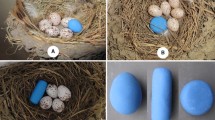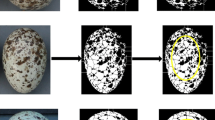Abstract
The phenomenon of intraspecific nest parasitism is of a great interest to biologists because it helps in the conservation of critically endangered birds like the Slender-billed Gull. Indeed, upon detecting a parasitic egg in the nest, the Slender-Billed Gull female abandon it. This behavior results in loosing large number of future birds and leads to its extension. So, a nest cleaning from parasitic eggs has been an urgent need. Therefore, in this paper, we suggest a Slender-Billed parasitic egg identification system from the egg visual information to clean the nest and avoid the female leaving. Encouraged by the success of the machine learning models in pattern recognition and classification, we have built a system which extracts the most important egg visual features and classify them using a set of machine learning models which have been aggregated together to attain a high parasitic egg identification accuracy. In fact, a set of egg visual features have been extracted from the eggshell using the SpotEgg tool which have provided information about the egg coloration and patterning such as the egg shape, size, color and spottiness. Our model has been evaluated on a 31-nest dataset and has given an accuracy of 88.3% which has outperformed other machine learning models.
Access this chapter
Tax calculation will be finalised at checkout
Purchases are for personal use only
Similar content being viewed by others
References
Atallah, R., Al-Mousa, A.: Heart disease detection using machine learning majority voting ensemble method. In: 2nd International Conference on New Trends in Computing Sciences (ICTCS), pp. 1–6 (2019)
Barbosa, A., Leonild, L., Hanlon, T.: Changeable cuttlefish camouflage is influenced by horizontal and vertical aspects of the visual background. J. Comp. Physiol. 194, 405–13 (2008)
Ben Aoun, N., Mejdoub, M., Ben Amar, C.: Bag of sub-graphs for video event recognition. In: 39th IEEE International Conference on Acoustics, Speech, and Signal Processing (ICASSP 2014), pp. 1566–1570 (2014). https://doi.org/10.1109/ICASSP.2014.6853857
Brahimi, S., Ben Aoun, N., Ben Amar, C.: Very deep recurrent convolutional neural network for object recognition. In: International Conference on Machine Vision (ICMV 2016), vol. 10341, p. 1034107 (2016). https://doi.org/10.1117/12.2268672
Brahimi, S., Ben Aoun, N., Ben Amar, C.: Improved very deep recurrent convolutional neural network for object recognition. In: IEEE International Conference on Systems, Man, and Cybernetics (SMC 2018), pp. 2497–2502 (2018). https://doi.org/10.1109/SMC.2018.00428
Brahimi, S., Ben Aoun, N., Ben Amar, C., Benoit, A., Lambert, P.: Multiscale fully convolutional densenet for semantic segmentation. J. WSCG 26(2), 104–111 (2018)
Cassey, P., et al.: Avian eggshell pigments are not consistently correlated with colour measurements or egg constituents in two Turdus thrushes. J. Avian Biol. 43, 503–12 (2012)
Chandra, M.A., Bedi, S.: Survey on SVM and their application in image classification. Int. J. Inf. Technol. 13, 1–11 (2021)
Chokri, M.A., Sadoul, N., Medhioub, K., Bechet, A.: Analyse comparative de la richesse avifaunistique du salin de Sfax dans le contexte tunisien et méditerranéen. Rev. d’Ecol. Terre et Vie 63(4), 351–369 (2008)
Chokri, M.A., Selmi, S.: Nesting phenology and breeding performance of the slender-billed gull Chroicocephalus genei in Sfax Salina, Tunisia. Ostrich 83(1), 13–18 (2012)
Dietterich, T.G.: Ensemble methods in machine learning. In: Kittler, J., Roli, F. (eds.) MCS 2000. LNCS, vol. 1857, pp. 1–15. Springer, Heidelberg (2000). https://doi.org/10.1007/3-540-45014-9_1
Gomez, J., Gordoi, O.: EGG recognition: the importance of quantifying multiple repeatable features as visual identity signals. PLoS One 16, 0248021 (2021)
Gómez, J., Liñán-Cembrano, G.: SpotEgg: an image-processing tool for automatised analysis of colouration and spottiness. J. Avian Biol. 48(4), 502–512 (2016)
Liñán-Cembrano, G., Gómez, J.: SpotEgg: measuring coloration and patterning. J. Avian Biol. 48(4), 502–512 (2017)
Malmasi, S., Dras, M.: Native language identification with classifier stacking and ensembles. Comput. Linguist. 44(3), 403–446 (2018)
Mejdoub, M., Ben Aoun, N., Ben Amar, C.: Bag of frequent subgraphs approach for image classification. Intell. Data Anal. 19(1), 75–88 (2015)
Ng, A., Jordan, M.: On discriminative vs. generative classifiers: a comparison of logistic regression and naive bayes. In: Advances in Neural Information Processing Systems, vol. 14 (2001)
Wiem, N., Ali, C.M., Ridha, E.: Wavelet feature with CNN for identifying parasitic egg from a Slender-Billed’s nest. In: Abraham, A., Hanne, T., Castillo, O., Gandhi, N., Nogueira Rios, T., Hong, T.-P. (eds.) HIS 2020. AISC, vol. 1375, pp. 365–374. Springer, Cham (2021). https://doi.org/10.1007/978-3-030-73050-5_37
Nhidi, W., Ejbali, R., Dahmen, H.: An intelligent approach to identify parasitic eggs from a Slender-Billed’s nest. In: Twelfth International Conference on Machine Vision (ICMV 2019), vol. 11433, p. 1143309. International Society for Optics and Photonics (2020)
Pavlyshenko, B.: Using stacking approaches for machine learning models. In: 2018 IEEE Second International Conference on Data Stream Mining & Processing (DSMP), pp. 255–258. IEEE (2018)
Pribisova, A., Martinez, C.: Model decision tree. Technical report, Sandia National Lab. (SNL-NM), Albuquerque, NM, USA (2021)
Priyam, A., Abhijeeta, G., Rathee, A., Srivastava, S.: Comparative analysis of decision tree classification algorithms. Int. J. Curr. Eng. Technol. 3(2), 334–337 (2013)
Pushpakumar, R., Prabu, R., Priscilla, M., Renisha, P., Prabu, R.T., Muthuraman, U.: A novel approach to identify dynamic deficiency in cell using gaussian NB classifier. In: 2022 7th International Conference on Communication and Electronics Systems (ICCES), pp. 31–37. IEEE (2022)
Spottiswoode, C.N., Stevens, M.: Visual modeling shows that avian host parents use multiple visual cues in rejecting parasitic eggs. Proc. Natl. Acad. Sci. 107(19), 8672–8676 (2010)
Stoddard, M.C., Hogan, B.G., Stevens, M., Spottiswoode, C.N.: Higher-level pattern features provide additional information to birds when recognizing and rejecting parasitic eggs. Philos. Trans. R. Soc. B 374(1769), 20180197 (2019)
Stoddard, M.C., Kilner, R.M., Town, C.: Pattern recognition algorithm reveals how birds evolve individual egg pattern signatures. Nat. Commun. 5, 4117 (2014)
Šulc, M., et al.: Automatic identification of bird females using egg phenotype. Zool. J. Linn. Soc. 195(1), 33–44 (2022)
Acknowledgement
The authors would like to acknowledge the financial support of this work through grants from the General Direction of Scientific Research (DGRST), Tunisia, under the ARUB program.
Author information
Authors and Affiliations
Corresponding author
Editor information
Editors and Affiliations
Rights and permissions
Copyright information
© 2023 The Author(s), under exclusive license to Springer Nature Switzerland AG
About this paper
Cite this paper
Nhidi, W., Ben Aoun, N., Ejbali, R. (2023). Ensemble Machine Learning-Based Egg Parasitism Identification for Endangered Bird Conservation. In: Nguyen, N.T., et al. Advances in Computational Collective Intelligence. ICCCI 2023. Communications in Computer and Information Science, vol 1864. Springer, Cham. https://doi.org/10.1007/978-3-031-41774-0_29
Download citation
DOI: https://doi.org/10.1007/978-3-031-41774-0_29
Published:
Publisher Name: Springer, Cham
Print ISBN: 978-3-031-41773-3
Online ISBN: 978-3-031-41774-0
eBook Packages: Computer ScienceComputer Science (R0)




